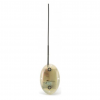Smart Position and Temperature (SPOT) Transmitting Tags
 Smart Position and Temperature (SPOT) Transmitting tags are perfect for studying species that spend large amounts of time at the ocean’s surface or come to the surface regularly. This satellite tag does not need to be recovered to collect the data thus a broader range of species can be studied. These devices have been used successfully to study sharks, seals, cetaceans, sea turtles and penguins. The only requirement is that the animal must have some aspect of its body that comes above the surface of the ocean. For airbreathing animals who come up periodically to breathe its rather easy to use this technology. More recently, TOPP researchers have placed the tags on the dorsal fins of shark with high success. As the sharks come back to the surface to bask in the warmth and the fixed fin sticks out providing the surface for attachment.
Smart Position and Temperature (SPOT) Transmitting tags are perfect for studying species that spend large amounts of time at the ocean’s surface or come to the surface regularly. This satellite tag does not need to be recovered to collect the data thus a broader range of species can be studied. These devices have been used successfully to study sharks, seals, cetaceans, sea turtles and penguins. The only requirement is that the animal must have some aspect of its body that comes above the surface of the ocean. For airbreathing animals who come up periodically to breathe its rather easy to use this technology. More recently, TOPP researchers have placed the tags on the dorsal fins of shark with high success. As the sharks come back to the surface to bask in the warmth and the fixed fin sticks out providing the surface for attachment.
Unlike archival tags, SPOT tags are equipped with powerful radio transmitters that communicate with satellites orbiting as far as 1000 km above the Earth. These specially equipped satellites are part of ARGOS – a global program that collects, processes and disseminates environmental data from fixed and mobile platforms worldwide. Argos receiver modules are attached to the National Oceanographic and Atmospheric Association’s (NOAA) low-orbiting weather satellites.
Whenever the antenna of a tag is above the water, the device can communicate with any Argos satellite that is within transmission range. On any given day, however, there are only a limited number of opportunities for data to be transmitted. These data are in the form of digital codes that must be deciphered. From these deciphered data, the location of the tag is calculated These calculated locations are considerably more accurate than those based upon light-based geolocation. To save battery life, these tags are often equipped with a saltwater switch so that the tag only transmits while the antenna is exposed to air. Using these tags, researchers can very accurately track the movements of large open sea animals for one to two years.
